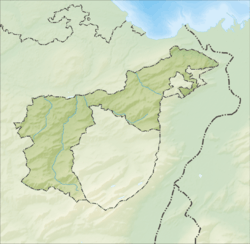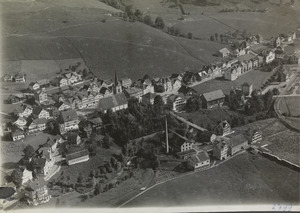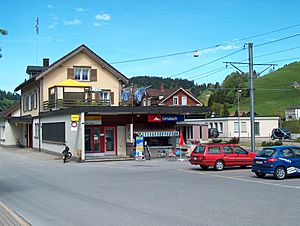Urnäsch facts for kids
Quick facts for kids
Urnäsch
|
||
|---|---|---|
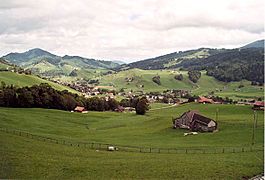 |
||
|
||
| Country | Switzerland | |
| Canton | Appenzell Ausserrhoden | |
| District | n.a. | |
| Area | ||
| • Total | 48.16 km2 (18.59 sq mi) | |
| Elevation | 826 m (2,710 ft) | |
| Population
(Dec 2020 )
|
||
| • Total | 2,263 | |
| • Density | 46.989/km2 (121.70/sq mi) | |
| Postal code |
9107
|
|
| Surrounded by | Hemberg (SG), Hundwil, Nesslau-Krummenau (SG), Schönengrund, Schwellbrunn, Waldstatt | |
Urnäsch is a small town, also called a municipality, in the canton of Appenzell Ausserrhoden, Switzerland. It's known for its beautiful nature and rich history.
Contents
History of Urnäsch
The area of Urnäsch was first mentioned way back in 831 AD. A part of it was called Färchen then. In the 10th century, Urnäsch was part of a bigger area called Herisau. Later, in the 14th century, it became part of the Rhode Hundwil. A Rhode was like a local district or area.
The whole town of Urnäsch was first officially named "Urnäschen" in 1344. This was when it was sold to a German Earl. However, Urnäsch was already quite independent. It even joined a group called the Schwäbischer Städtebund (Swabian League of Cities) that same year. This showed how independent it was.
In 1401, Urnäsch joined forces with St. Gallen. Even then, it was still part of the Rhode Hundwil. From 1401 to 1429, Urnäsch was a key player in the Appenzell Wars. After important battles, the land gained its independence as part of Appenzell.
Becoming Independent
Before 1414, people from Urnäsch had to travel far to go to church in Herisau. But in 1414, a new church was built right in Urnäsch! This helped the town become truly independent in 1417 when the church opened.
In 1480, Urnäsch and Hundwil went their separate ways. In 1525, Urnäsch joined the Reformation, which was a big change in how people practiced their religion. Since 1597, Urnäsch has been part of Appenzell Ausserrhoden. It was one of the six main Rhoden (districts) and often hosted important meetings.
Fires and Changes
In 1641, a big fire swept through the village. It burned down the church, the town hall, the priest's house, and many other homes. The church was rebuilt quickly. It was later fixed up again between 1866 and 1888.
Until 1722, the nearby town of Schönengrund was part of Urnäsch. But in that year, Schönengrund became independent. Since then, the borders of Urnäsch have stayed the same.
Modern Times
Starting in the mid-1800s, tourism became important for Urnäsch. More people started visiting! In 1853, the town's first bridge was built. Then, in 1875, a train station opened, making it easier for people to get there. In the 20th century, better public transport connections helped Urnäsch grow even more.
Geography of Urnäsch
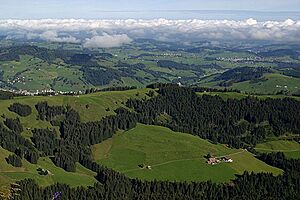
Urnäsch covers an area of about 48.3 square kilometers (about 18.6 square miles). A large part of this land, about 53.9%, is used for farming. Forests cover another 41.1% of the area.
About 3.4% of the land has buildings or roads. The rest, about 1.7%, is made up of things like rivers, glaciers, or mountains.
The main village of Urnäsch is about 838 meters (2,749 feet) above sea level. The lowest point in the area is the Murbach river, at 722 meters (2,369 feet). The highest point is the Petersalp, which reaches 1,590 meters (5,217 feet) high.
People of Urnäsch (Demographics)
As of 2008, Urnäsch had a population of 2,268 people. About 11.6% of these people were from other countries. Over the past 10 years, the population has gone down a little bit.
Most people in Urnäsch (about 93%) speak German. Serbo-Croatian is the second most common language, and Italian is third.
In 2000, about 50.6% of the people were male and 49.4% were female. Here's a quick look at the age groups in 2000:
- 9.2% were very young children (0-6 years old).
- 13.5% were kids aged 6-15.
- 5.2% were teenagers aged 16-19.
- Most people, about 27.9%, were adults aged 25-44.
- About 57.4% of adults (aged 25-64) in Urnäsch have finished high school or gone on to higher education like university.
Population Over Time
Here's how the population of Urnäsch has changed over many years:
| Historical population | ||
|---|---|---|
| Year | Pop. | ±% |
| 1850 | 2,464 | — |
| 1870 | 2,564 | +4.1% |
| 1888 | 3,123 | +21.8% |
| 1900 | 3,087 | −1.2% |
| 1920 | 3,202 | +3.7% |
| 1941 | 2,481 | −22.5% |
| 1960 | 2,330 | −6.1% |
| 1980 | 2,258 | −3.1% |
| 2000 | 2,322 | +2.8% |
| 2010 | 2,278 | −1.9% |
| 2020 | 2,263 | −0.7% |
| 2022 | 2,290 | +1.2% |
Weather in Urnäsch
Urnäsch gets a good amount of rain each year. On average, it has 161.6 days of rain and receives about 1,803 millimeters (71 inches) of rain.
The wettest month is June, with about 210 millimeters (8.3 inches) of rain over 15.5 days. May has the most rainy days (15.8 days) but a bit less rain overall. The driest month is October, with about 107 millimeters (4.2 inches) of rain over 15.5 days.
Economy of Urnäsch
Urnäsch has a low unemployment rate, which means most people who want to work can find jobs.
The town's economy is split into three main parts:
- Primary sector: This includes farming and forestry. About 215 people work in this area, with 96 businesses. There are almost 100 farms in the village.
- Secondary sector: This involves making things, like manufacturing. About 246 people work here, with 28 businesses.
- Tertiary sector: This is about services, like shops, hotels, and restaurants. About 496 people work in this sector, with 79 businesses. There are 18 hotels and restaurants in Urnäsch.
Transport in Urnäsch
Urnäsch has two train stations: Urnäsch and Zürchersmühle. Both are on the Gossau–Wasserauen line, which is part of the Appenzell Railways network. This makes it easy to travel to and from the town.
Important Heritage Sites
Urnäsch is home to some special places that are considered important national heritage sites. These include:
- The Museum für Appenzeller Brauchtum (Museum of Appenzell Customs). This museum shows the traditional ways of life in the Appenzell region.
- The Mill House and its old Mill. These buildings are a great example of historical architecture and how things used to be made.
See also
 In Spanish: Urnäsch para niños
In Spanish: Urnäsch para niños




